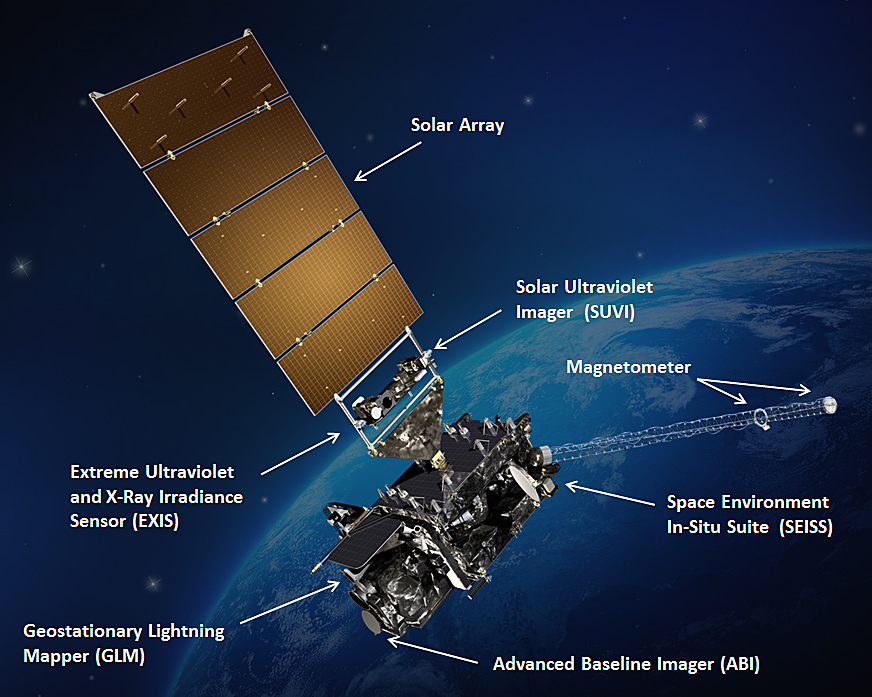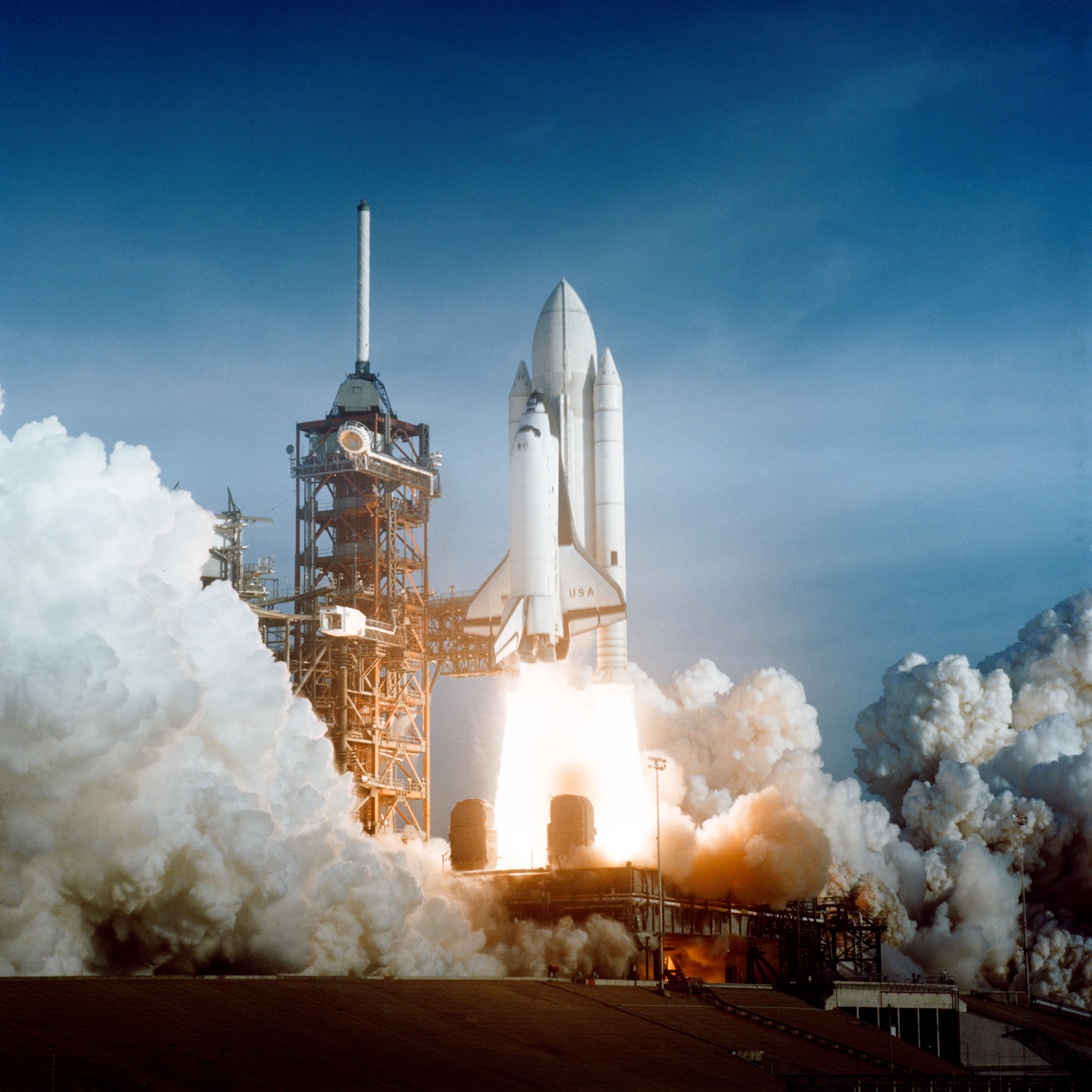|
GOES 8
GOES-8, known as GOES-I before becoming operational, was an American weather satellite, which formed part of the US National Oceanic and Atmospheric Administration's Geostationary Operational Environmental Satellite system. It was launched in 1994, and operated until 2004 when it was retired and boosted to a graveyard orbit. At launch, the satellite had a mass of , and an expected operational lifespan of three or five years. It was built by Space Systems/Loral, based on the LS-1300 satellite bus, and was the first of five GOES-I series satellites to be launched. Launch GOES-I was launched aboard a Martin Marietta Atlas I rocket, flying from Launch Complex 36B at the Cape Canaveral Air Force Station. The launch occurred at 06:04 GMT on 13 April 1994, and placed the satellite into a geosynchronous transfer orbit. It was then raised into geostationary orbit by means of an R-4D-11 apogee motor. During the first burn of the apogee motor, an unusually high temperature was detected in ... [...More Info...] [...Related Items...] OR: [Wikipedia] [Google] [Baidu] |
Weather Satellite
A weather satellite or meteorological satellite is a type of Earth observation satellite that is primarily used to monitor the weather and climate of the Earth. Satellites can be polar orbiting (covering the entire Earth asynchronously), or geostationary (hovering over the same spot on the equator). While primarily used to detect the development and movement of storm systems and other cloud patterns, meteorological satellites can also detect other phenomena such as city lights, fires, effects of pollution, auroras, sand and dust storms, snow cover, ice mapping, boundaries of ocean currents, and energy flows. Other types of environmental information are collected using weather satellites. Weather satellite images helped in monitoring the volcanic ash cloud from Mount St. Helens and activity from other volcanoes such as Mount Etna. Smoke from fires in the western United States such as Colorado and Utah have also been monitored. El Niño and its effects on weather are mo ... [...More Info...] [...Related Items...] OR: [Wikipedia] [Google] [Baidu] |
Spacecraft Launched In 1994
A spacecraft is a vehicle or machine designed to spaceflight, fly in outer space. A type of artificial satellite, spacecraft are used for a variety of purposes, including Telecommunications, communications, Earth observation satellite, Earth observation, Weather satellite, meteorology, navigation, space colonization, Planetary science, planetary exploration, and Space transport, transportation of Human spaceflight, humans and cargo spacecraft, cargo. All spacecraft except single-stage-to-orbit vehicles cannot get into space on their own, and require a launch vehicle (carrier rocket). On a sub-orbital spaceflight, a space vehicle enters outer space, space and then returns to the surface without having gained sufficient energy or velocity to make a full Earth orbit. For orbital spaceflights, spacecraft enter closed orbits around the Earth or around other Astronomical object, celestial bodies. Spacecraft used for human spaceflight carry people on board as crew or passengers from ... [...More Info...] [...Related Items...] OR: [Wikipedia] [Google] [Baidu] |
List Of GOES Satellites
This is a list of Geostationary Operational Environmental Satellites. GOES spacecraft are operated by the United States National Oceanic and Atmospheric Administration, with NASA responsible for research and development, and later procurement of spacecraft. Imagery File:First image from GOES Spac0041.jpg, SMS-derived File:Img-1989-09-19-18-GOE-7-IR.jpg, First-generation File:BW Goes8vis1big.png, Second-generation File:BW 060622_goes13_medium.gif, Third-generation File:GOES 4th Generation full disk imagery.png, Fourth-generation Satellites References {{spaceflight lists and timelines * GOES ... [...More Info...] [...Related Items...] OR: [Wikipedia] [Google] [Baidu] |
1994 In Spaceflight
This article outlines notable events occurring in 1994 in spaceflight Spaceflight (or space flight) is an application of astronautics to fly spacecraft into or through outer space, either with or without humans on board. Most spaceflight is uncrewed and conducted mainly with spacecraft such as satellites in or ..., including major launches and EVAs. Launches , colspan="8", January , - , colspan="8", February , - , colspan="8", March , - , colspan="8", April , - , colspan="8", May , - , colspan="8", June , - , colspan="8", July , - , colspan="8", August , - , colspan="8", September , - , colspan="8", October , - , colspan="8", November , - , colspan="8", December , - Deep Space Rendezvous EVAs References Footnotes {{DE ... [...More Info...] [...Related Items...] OR: [Wikipedia] [Google] [Baidu] |
GOES 12
GOES-12, known as GOES-M before becoming operational, is an American weather satellite, which is part of the US National Oceanic and Atmospheric Administration's Geostationary Operational Environmental Satellite system. It was launched on July 23, 2001, and spent its first 21 months in space as an on-orbit spare. From April 2003, the satellite took over the GOES-East position, providing coverage of the eastern half of the continental United States. In April 2010, GOES-East operations were taken over by GOES-13, and GOES-12 transitioned to the GOES-South location to devote time to South American imagery. It remained at this post until it was decommissioned on August 16, 2013 and subsequently boosted to a graveyard orbit. Launch GOES-M was launched aboard an International Launch Services Atlas IIA rocket, flying from Space Launch Complex 36A at the Cape Canaveral Air Force Station. The launch occurred at 07:23 GMT on 23 July 2001, having previously been delayed eight days; se ... [...More Info...] [...Related Items...] OR: [Wikipedia] [Google] [Baidu] |
Twister (1996 Film)
''Twister'' is a 1996 American epic disaster film directed by Jan de Bont from a screenplay by Michael Crichton and Anne-Marie Martin. It was produced by Crichton, Kathleen Kennedy and Ian Bryce, with Steven Spielberg, Walter Parkes, Laurie MacDonald, and Gerald R. Molen serving as executive producers. The film stars an ensemble cast that includes Helen Hunt, Bill Paxton, Jami Gertz, Cary Elwes, Philip Seymour Hoffman, Alan Ruck, Todd Field, and Jeremy Davies as a group of amateur but spirited storm chasers trying to deploy a tornado research device during a severe outbreak in Oklahoma. ''Twister'' was officially released in theaters on May 10, 1996. It is notable for being the first film to be released on DVD in the United States. ''Twister'' grossed $495 million worldwide and became the second-highest-grossing film of 1996; it sold an estimated 54.7 million tickets in the U.S. It received generally positive reviews from critics, as some praised the visual ef ... [...More Info...] [...Related Items...] OR: [Wikipedia] [Google] [Baidu] |
GOES 10
Goes () is a city and municipality in the southwestern Netherlands on Zuid-Beveland, in the province of Zeeland. The city of Goes has approximately 27,000 residents. History Goes was founded in the 10th century on the edge of a creek: de Korte Gos (the Short Gos). The village grew fast, and in the early 12th century it had a market square and a church devoted to Mary Magdalene. By 1300 it had a brick castle, now known as Oostende Castle. In 1405 Goes received city rights from William, Duke of Bavaria, by his right as count of Holland, and in 1417 it was allowed to build town walls. The prosperity of the city was based upon the cloth industry and the production of salt. In the 16th century Goes declined. Its connection to the sea silted up and in 1554 a large fire destroyed part of the city. In the Autumn of 1572, during the course of the Eighty Years' War, Goes, in the Spanish Netherlands, was besieged by Dutch forces with the support of English troops. The siege was re ... [...More Info...] [...Related Items...] OR: [Wikipedia] [Google] [Baidu] |
GOES 9
GOES-9, known as GOES-J before becoming operational, was an American weather satellite, which formed part of the U.S. National Oceanic and Atmospheric Administration's Geostationary Operational Environmental Satellite system. It was launched in 1995, and operated until 2007 when it was retired and boosted to a graveyard orbit. At launch, the satellite had a mass of , and an expected operational lifespan of three years. It was built by Space Systems/Loral, based on the LS-1300 satellite bus, and was the second of five GOES-I series satellites to be launched. Launch GOES-J was launched aboard an International Launch Services Atlas I rocket, flying from Launch Complex 36B at the Cape Canaveral Air Force Station. The launch occurred at 05:52:02 GMT on 23 May 1995. Following launch, it was positioned in geostationary orbit at a longitude of 90° West for on-orbit testing. Once this was complete, it was moved to 135° West, where it assumed GOES-WEST operations. Operations GOES-9 su ... [...More Info...] [...Related Items...] OR: [Wikipedia] [Google] [Baidu] |
BW Goes8vis1big
BW or Bw may stand for: Businesses and organizations * Baldwin Wallace University, formally called Baldwin-Wallace College located in Berea, Ohio * Bergesen Worldwide, a shipping company * Best Western, a hospitality company. * Bolton Wanderers, an English football club * British Waterways, a body that looks after the majority of inland waterways in the UK * Brush Engineered Materials (NYSE stock symbol BW) * Bundeswehr, the armed forces of modern Germany * BWIA West Indies Airways (IATA Airline code BW) * Caribbean Airlines (IATA airline code BW) Places * Baden-Württemberg, a federal state of Germany * Brabant Wallon ''(Walloon Brabant)'', a province of Belgium * Bangladesh (World Meteorological Organization country code) * Botswana (ISO 2-letter country code) **.bw, the country-code Top Level Domain for Botswana In science and technology * Bahnbetriebswerk, a type of German locomotive depot * Bandwidth (other) * Bargmann–Wigner equations, in quantum field theory ... [...More Info...] [...Related Items...] OR: [Wikipedia] [Google] [Baidu] |
GOES 7
GOES-7, known as GOES-H before becoming operational, is an American satellite. It was originally built as a weather satellite, and formed part of the US National Oceanic and Atmospheric Administration's Geostationary Operational Environmental Satellite system. Originally built as a ground spare, GOES-H was launched in 1987 due to delays with the next series of satellites. It was operated by NOAA until 1999, before being leased to Peacesat, who use it as a communications satellite. As of 2009, it was operational over the Pacific Ocean, providing communications for the Pacific Islands. On April 12, 2012, the spacecraft was finally decommissioned and moved to a graveyard orbit. Launch GOES-H was launched aboard a McDonnell Douglas Delta 3914 rocket, flying from Launch Complex 17A at the Cape Canaveral Air Force Station. The launch occurred at 23:05 GMT on 26 February 1987. The launch had originally been scheduled for late 1986, but was delayed after GOES-G failed to achieve orbit. ... [...More Info...] [...Related Items...] OR: [Wikipedia] [Google] [Baidu] |
Longitude
Longitude (, ) is a geographic coordinate that specifies the east– west position of a point on the surface of the Earth, or another celestial body. It is an angular measurement, usually expressed in degrees and denoted by the Greek letter lambda (λ). Meridians are semicircular lines running from pole to pole that connect points with the same longitude. The prime meridian defines 0° longitude; by convention the International Reference Meridian for the Earth passes near the Royal Observatory in Greenwich, England on the island of Great Britain. Positive longitudes are east of the prime meridian, and negative ones are west. Because of the Earth's rotation, there is a close connection between longitude and time measurement. Scientifically precise local time varies with longitude: a difference of 15° longitude corresponds to a one-hour difference in local time, due to the differing position in relation to the Sun. Comparing local time to an absolute measure of ti ... [...More Info...] [...Related Items...] OR: [Wikipedia] [Google] [Baidu] |





